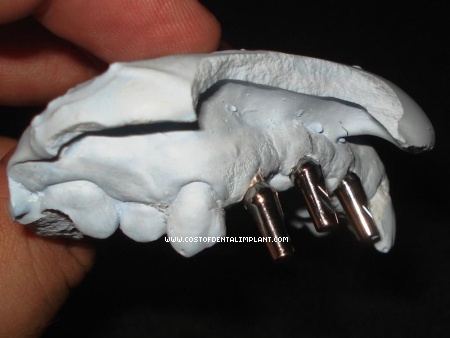
Dental Implants Cost
The cost of dental implants depends on several factors like: the number of implants to be placed, implant system to be used, the fee of dentists performing the procedure and the location where the implant placement restoration is performed. These are only the major ones that have a big impact on the final cost.
Other factors are: how much bone is left in the patient’s upper or lower jaw, specialization of the dentist, difficulty of the case and fees charged by dental technologist/dental laboratory
Single implants may range in cost from $1,000 to $3,000 while the cost of full-mouth implant restoration can range from $6,000 to $100,000.
Dental implant treatment is usually not covered by dental insurance.
Advantages of Dental Implants
A dental implant replaces the root of your missing tooth. It is basically an artificial root placed by an oral surgeon or a periodontist. Dental implants will hold or support the denture or dental crowns cemented or screwed on top of them. With dental implants, you will still wear a denture. The difference is your prosthesis is more stable and secured.
Dental implant restoration is conservative if you compare it to traditional fixed bridge. Traditional bridgework requires reduction to adjacent teeth for them to hold the prosthesis. While in implant dentistry, the adjacent teeth will remain intact because the dental implant will hold the crown or denture in place.
Implants offer a long term solution to tooth loss. If maintained correctly, dental implants are stable and functionally durable.
Dental Implant Candidate
If you are allowed to undergo tooth extraction in the past, you are normally a good candidate for implants. If not, you should consult a dentist offline. Choose a dentist who has undergone an extensive training on Implant Dentistry.
In implant dentistry, periodontists tend to understand tissue better while prosthodontists can make the most ideal restoration. The concept in the practice of dental implant is prosthodontic driven and not bone driven.
Dental Implant Treatment Indications
Indications for dental implant treatment
1. Edentulous patient.
2. Partially edentulous patient with difficulty in wearing removable partial dentures.
3. Patient with missing dentition requiring long span dental bridge.
4. Patients refusing to use a removable denture.
Dental Implant Treatment Contraindications
Absolute contraindications to dental implant treatment
1. High dose irradiated patients.
2. Patient with psychiatric problems like psychoses, dysmorphophobia.
3. Hematologic systemic disorders.
Relative contraindications to dental implant treatment
1. pathology of hard or soft tissues,
2. patient with drug, alcohol or chewing tobacco abuse
3. Low dose irradiated patients.
Radiation therapy is defined as the therapeutic use of ionizing radiation. In irradiation of implants in bone, it is recommended the removal of all abutments and superstructures and closure of skin and mucosa over the implants prior to radiation. Medical conditions, like active diabetes, cancer or periodontal disease, require treatment before a dental implant procedure can be performed.
Factors to Consider in Dental Implant Treatment
1. How does the patient feel about surgery?
2. Is the patient prepared to pay the costs involved in implant theraphy?
3. Does the patient have sufficient bone to place dental implants? Bone grafting may be required and this could be a barrier to treatment.
4. If bone grafting is required, is the patient prepared to accept this?
5. Is the patient prepared to accept the burden of maintenance associated with implant retained prosthesis?
Success of Dental Implants
Based on recent studies, dental implants have 96% success rate. Bone quantity and quality influence success rates of the Implant Procedure. The upper anterior region has less bone quality and lower bone quantity when compared to the lower anterior region. A fully implant supported prosthesis in the maxilla has a lower success rate than in the mandible due to different bone densities.
Standards for Success of Implants
1. That an individual, unattached implant is immobile when tested clinically.
2. That a radiograph does not demonstrate any evidence of peri-implant radiolucency.
3. That vertical bone loss be less than 0.2 mm annually following the implant’s first year of service.
4. That an individual implant performance be characterized by an absence of persistent and/or irreversible signs and symptoms such as pain, infections, neuropathies, paresthesia or violation of mandibular canal.
5. That in context of the above, a success rate of 85% at the end of a 5 year observation period and 80% at the end of a ten-year period be a minimum criterion for success.
Dental Implant Risks
There are 2 main reasons why implants would fail: poor oral hygiene and wrong prosthodontic treatment (denture component). Sound prosthodontic principles are important to osseointegrated dental implants. Poorly restored occlusion in osseointegrated dental implants could result in deleterious effects to the prosthesis and supporting bone.
Good plaque control is important in preventing complications such as peri-implantitis around dental implants. Periimplantitis is a disease that is similar to the development of periodontitis.
Hygiene maintenance is tedious and requires considerable effort.
Mini Dental Implants
Mini Dental Implants are small diameter implants that are designed to stabilize the lower denture. MDIs should not be used as conventional dental implants. Read the mini dental implants post for more info.
References
Granstrom G, Tjellstrom A, ALbrektsson T: Postimplantation irradiation for head and neck cancer treatment. Int J Oral Maxillofacial Implants 1993;8(4):495-500.
Albretsson T, Zarb G, Worthington P, Eriksson A: The long term efficacy of currently used implants. A review and proposed criteria of success. Int J of Oral Maxillofac Imp, 1:11-25, 1986
Written by:
Jesus Lecitona+, DMD, MScD-Prosthodontics
Like this:
Like Loading...





